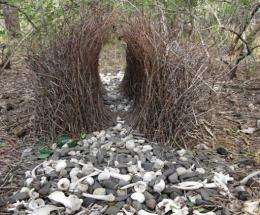In birds, masters of illusion are lucky in love

Many male birds use their flashy colored feathers to lure females, but the great bowerbird of Australia has mastered the art of illusion to captivate the ladies, researchers said Thursday.
Part architect, part magician, the great bowerbird constructs an elaborate arched walkway called a bower made from twigs.
Then he strategically places fruit, shells, bones and rocks outside it so they may appear larger, or smaller, or simply more compelling to a female who considers him for a mate.
When the female enters his archway and watches, the male uses his beak to pick up the little gems on his stage and wave them before her eyes, using a series of optical illusions to keep her attention, said the study in Science.
The key illusion is forced perspective, in which objects' true size appears distorted due to the distance at which they are placed.
For instance, larger objects that are farther away from the viewer will appear the same size as closer, smaller objects.
Also, a rock encircled by larger rocks will look smaller than the same size rock surrounded by tiny objects, known as the Ebbinghaus illusion.
"If the female watches him long enough, then he runs around the back and mates with her," lead author John Endler of Australia's Deakin University told AFP.
All he needs is a few moments of her undivided attention, added Endler.
"Females watch males one to 12 minutes before mating, mostly around two minutes."
But if she doesn't like the display, chances are she will choose a male who is better at mastering the illusion effect, said Endler who along with colleague Laura Kelley monitored the birds by hidden camera.
They found that the ultra-competitive males would sometimes trash a comrade's bower in a bid to unseat a rival on the eve of a potential mating ritual.
In a fierce rush to stay in the race, the disheveled male would inevitably rebuild his bower by daylight.
"It is amazing," Endler said. "The structure is 0.6 meters long by 0.5 meters wide and high and very densely thatched, but if it is trashed by a neighboring bowerbird -- not rare! -- in the evening, it is fully built by the next morning.
"I've never actually seen them building because it is always done by the time it is light enough for the camera to record," he said.
The researchers are still puzzled as to why the illusion, when done right, works so well. Could it be that it makes the shells and rocks look like larger tokens, or gifts?
Or could the lady just be falling sway to the pure joy of entertainment?
"It might just make the displayed objects look more conspicuous, or hold her attention while she looks at the display," Endler said.
"At the moment all we know is that better perspective means more mates, we do not know why."
Great bowerbirds may be the masters of illusion, but are not alone in the craft, the researchers said.
Mistle thrushes, gray parrots and pigeons have also been shown to be sensitive to the power of illusion.
More information: "Illusions Promote Mating Success in Great Bowerbirds," Science Express.
(c) 2012 AFP



















